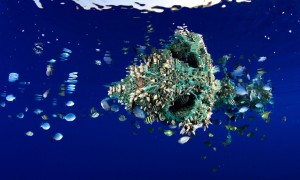 More than five trillion pieces of plastic, collectively weighing nearly 269,000 tonnes, are floating in the world’s oceans, causing damage throughout the food chain.
More than five trillion pieces of plastic, collectively weighing nearly 269,000 tonnes, are floating in the world’s oceans, causing damage throughout the food chain.
Data collected by scientists from the US, France, Chile, Australia and New Zealand suggests a minimum of 5.25tn plastic particles in the oceans, most of them “micro plastics” measuring less than 5mm.
The volume of plastic pieces, largely deriving from products such as food and drink packaging and clothing, was calculated from data taken from 24 expeditions over a six-year period to 2013. The research, published in the journal PLOS One, is the first study to look at plastics of all sizes in the world’s oceans and will be used to chart future trends in the amount of debris in the oceans.
Large pieces of plastic can strangle animals such as seals, while smaller pieces are ingested by fish and then fed up the food chain, all the way to humans. This is problematic due to the chemicals contained within plastics, as well as the pollutants that plastic attract once they are in the marine environment.
While spread out around the globe, much of this rubbish accumulates in five large ocean gyres, which are circular currents that churn up plastics in a set area. Each of the major oceans have plastic-filled gyres, including the well-known ‘great Pacific garbage patch’ that covers an area roughly equivalent to Texas.
Julia Reisser, a researcher based at the University of Western Australia, said traversing the large rubbish-strewn gyres in a boat was like sailing through “plastic soup.”“You put a net through it for half an hour and there’s more plastic than marine life there,”
Researchers have predicted the volume of plastic in the ocean will increase due to rising production of throwaway plastic, with only 5% of the world’s plastic currently recycled.
“Lots of things are used once and then not recycled,” Reisser said. “We need to improve our use of plastic and also monitor plastics in the oceans so we get a better understanding of the issue. Policy makers need to understand the problem. Some are doing that – Germany has changed the policy so that manufacturers are responsible for the waste they produce. If we put more responsibility on to the producer then that would be part of the solution.”
Read more:
Full Scale of plastic in the world’s oceans revealed for the first time | The Guardian
More than 5 trillion pieces of plastic afloat at sea | PLOS One